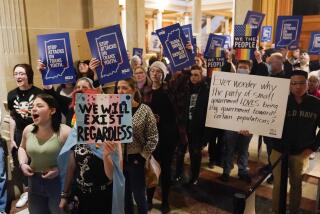BOOK REVIEW : Where Science, Sexuality and the Law Collide : SEXUAL SCIENCE AND THE LAW, <i> by Richard Green</i> , Harvard University Press $35; 323 pages
- Share via
Is there such a thing as “sexual science”? If there is, should our laws adjust to its findings? Richard Green does not address this question in “Sexual Science and the Law” because he assumes such a science exists and ought to be considered.
Green, a professor of law at UCLA as well as a psychiatrist, believes that although “sexuality is different” (from what, he doesn’t say), science has probed the subject sufficiently to suggest that many laws are out of step with current knowledge.
He is not alone. As if to underline his claim, the National Research Council, a branch of the National Academy of Science, recommended in a four-volume report published earlier this month that biological and genetic factors be considered in efforts to understand the perpetrators of violence.
Green’s book includes this issue as well as four chapters on homosexuality, another on transsexualism, one on pornography and another on intergenerational sex and incest. Each of Green’s chapters begins with a legal history of the issue, followed by quotes from relevant new cases.
At first glance the book seems to mix apples and oranges: the Kinsey reports, neurobiological investigations of autopsied brains, laws against fornication between consenting adults who do not happen to be married to each other and the rights of convicted murderers to costly sex-change operations.
What justifies including them in a single book is not so much the kind or quality of the scientific research as their common confrontation with changing societal standards.
The trouble is, those standards are hard to pinpoint, and public opinion has polarized attitudes about what is equitable and morally right. Ever since Freud pointed out the importance of sex in human behavior, those who study it have been at odds with each other and with Scripture, which prescribes precisely what is and is not permissible.
Take the matter of homosexuality, a biblically forbidden practice. Between 1917 and 1970, Green tells us, the United States forbade the immigration of homosexuals. As recently as 1973, the American Psychiatric Assn. defined homosexuality as a disease.
This definition was incorporated into a 1930 immigration law designed to prevent “tainted” persons (those with poor genes) from further corrupting the American gene pool--although it is hard to see how, from homosexuals, this seemed a threat.
Psychiatrists now say sexual orientation is determined at an early age and cannot be changed. The new Roman Catholic Catechism acknowledges that homosexuals do not choose this path. This is important insofar as U.S. law states that individuals ought not be constrained for immutable traits over which they have no control.
There is some evidence that connects sex and violence. Several years ago, a flurry arose over the discovery of an extra “Y” chromosome in men convicted of violent acts. On the distaff side, there are data linking hormones to premenstrual violence. Surely these are, also, immutable. Do we incarcerate these people, treat them involuntarily with behavior-altering hormones or surgery? What about their civil liberties?
Green bravely treads the most controversial ground--adult-child sexuality and incest. Green offers evidence that many children who have sexual relations with adults--often their own parents--are none the worse for it.
Playing devil’s advocate, he mentions that these experiences are routine in some cultures, and he quotes members of the English pedophile movement who claim that to prohibit children from enjoying the embraces of kindly adults is inhibiting their rights, as well as those of the good-natured pedophiles.
American courts use the Frye Rule to decide which evidence ought to be accepted as scientific. This rule defines “acceptable” as that science which “is sufficiently established to have gained general acceptance in the particular field to which it belongs.”
But even when sexual science experts pass the Frye test, Green reminds us, they still must convince a jury. Green posits the hypothetical case of siblings, separated at birth, who meet, fall in love, wish to marry and are also of the same sex. At this conjuncture of behaviors, he says, “intolerance, indignation and disgust” win out.
Many of Green’s arguments are convincing and all are important to ponder. What cannot be ignored, however, is that there is no single sexual science but many sciences, all conducted by scientists who, like the rest of us, reflect the biases of time, place and gender.
More to Read
Sign up for our Book Club newsletter
Get the latest news, events and more from the Los Angeles Times Book Club, and help us get L.A. reading and talking.
You may occasionally receive promotional content from the Los Angeles Times.










